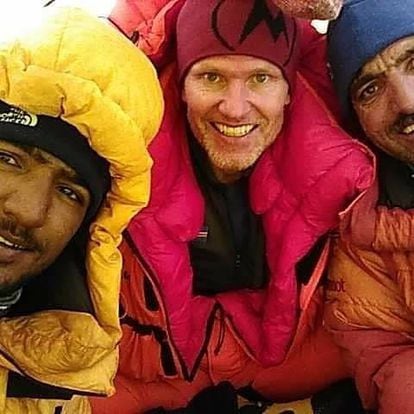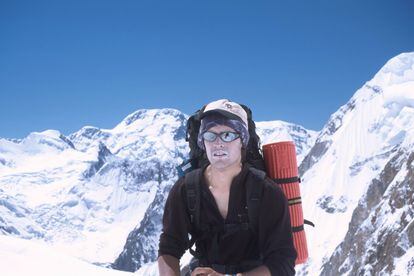The hazards of mountain climbing: What ought to be done with the corpses of climbers in the Himalayas? | United states
The bodies of three climbers – Ali Sapdara from Pakistan, Icelander John Snorri and Chilean Juan Pablo Mohr – were being located previous thirty day period, on July 26, after heading lacking for practically six months in the optimum section of K2, the world’s next-maximum mountain (8,611 meters). A team of Nepalese Sherpas came throughout them as they ascended the normal Abruzzi Spur route.
The final human being to see the trio alive through the fierce Karakorum wintertime was Ali Sapdara’s son, Sajid Sapdara: at initially gentle on February 5, his synthetic oxygen regulator unsuccessful and he resolved to forego the summit. The temperature hovered about -40ºC as the remaining team tackled the notoriously tough Bottle Neck. Devoid of realizing it, Sajid was stating a previous goodbye to his father, his father’s shopper, John Snorri, and the Chilean Mohr. Mohr himself was ascending with out the help of artificial oxygen, determined to reach the summit as a tribute to his Spanish mate, Sergi Mingote, who experienced died a few times previously although functioning on his acclimatization. The dwindling group aimed to be the first to summit K2 in wintertime. The climate window was modest. Fatally so. When a climber dies, the agony and the unanswered inquiries of his family start out.

The Sherpas came throughout the continues to be of Mohr at 7,955 meters, extremely shut to wherever the very last altitude camp, Camp 4, is frequently located just before the last leg to the summit. On February 5, from within his tent at Camp 3 (7,330 meters), Sajid saved a light on through the evening to information the trio, nevertheless he never saw them. Ali’s physique was discovered at 8,300 meters, connected to a fastened rope, as was Snorri’s, just a few meters higher than him. All died on the way down, as indicated by the descent products attaching Ali and Snorri’s harnesses to the preset ropes. The night time they established off for the summit, the intensity of the wind increased. Their fatalities were virtually unquestionably brought on by fatigue and excessive chilly. The discovery of the bodies on July 26 was a reduction to Sajid, who was also back again on the mountain in lookup of their remains. He was obsessed with the concept of discovering out what transpired following he was separated from the team: did they arrive at the summit? Did they have an accident? Sajid recovered cameras, GPS and watches from the bodies in a bid to reconstruct the a few climbers’ journey to the peak. The complete story is not however recognized, even though it is clear they neither bought lost nor had an incident.
The a lot more fragile problem, of training course, was what to do with the stays. At initially there was speculation that the bodies would be taken out from the mountain with the aid of helicopters, but to fly a helicopter at 8,000 meters is really hard. Nor is it effortless to get the bodies down the mountain – that would entail lots of mountaineers who would be subjected to a large stage of risk. Finally, Sajid bought support from Bolivian Hugo Ayaviri to shift his father from 8,300 meters to a position near Camp 4 at 7,900 meters, where he buried him, according to his mother’s recommendations, involving a spiritual ritual. He also buried the remains of Snorri and Mohr the place they lay and is even now choosing regardless of whether it is possible to carry them more down the mountain.
In Europe, as on the rest of the “accessible” western peaks, mountaineers’ bodies are often recovered. But in mountain ranges as distant as the Himalayas, the rescue of corpses is significantly extra intricate and dangerous, and a lot of are never ever introduced home. Everest is the most notorious for this as summit events report owning occur confront to experience with loss of life en route. There is no legislation that requires the restoration of these remains, so it is up to the people to make your mind up what to do, a conclusion that can be heartbreaking.

Basque climber Félix Iñurrategi died just before his brother Alberto’s eyes, in 2000, for the duration of the descent of Gasherbrum II (8,035 m), the world’s 13th-greatest mountain on the border in between China and Pakistan. His entire body fell down a precipice off the real route onto an impassable glacier. Alberto decided that this would be his brother’s grave. “I’ve considering that handed the place where by Felix fell three moments, but I’ve in no way even attempted to go there,” he states. “If it had been on the route, I never know what I would have resolved… I suppose that when he fell in a area with this kind of intricate accessibility, the dilemma solved alone. The fact is that mountaineering is an action missing set up regulations,” he adds. “So absolutely everyone interprets them in their individual way, and the issue of deaths in distant mountains has not been subject to debate: no just one has sat down to build a typical protocol in these instances, like, need to they be buried in a position where no one particular can locate them? Need to the bodies be introduced down? There is a lack of common standards.”
Xabier Ormazabal, also from the Basque Place, was 23 several years outdated when he died all through the descent of Cho Oyu (8,201 m) on the China-Nepal border in 2004. He was by yourself on the mountain and in good condition, having not long ago done the Snow Leopard, an award specified to these who climb the former Soviet Union’s five maximum peaks of 7,000 meters and higher than.
Following his death, his system was remaining in the middle of the entry route, really shut to the mountain’s Camp 2, in simple sight. At initially, the relatives needed the body to continue being right there, the spot Xabi loved, but, as his brother Andoni recollects, Spanish climber Iñaki Ochoa de Olza designed them see the concept was impractical.
“Iñaki explained to us that he understood of related conditions and that, from his working experience, it would be far better in the extended operate if the relatives could get well the continues to be and say goodbye,” states Andoni. “Besides, Xabi was in the middle of the route of a hugely commercial mountain and pics of his stays would soon begin circulating on the world wide web and that was one thing that would grow to be unbearable for us. On the other hand, we did not want any person to put their life at risk recovering the human body, but getting at a somewhat obtainable altitude [7,000 meters], the Sherpa group that introduced him down from the mountain was in no threat.”
Soon after cremating the stays, the notion was to scatter Xabi’s ashes in the Aralar mountain vary in the Basque Place. “But in the stop my mom preferred to continue to keep the urn,” claims Andoni. “It’s critical for her to have a modest altar, a position to try to remember. What is certain is that we needed peace we required to be capable to say goodbye, to switch the web site, to keep on with the pain but not with the nightmare of recognizing that Xabi was lying there just before the indifferent gaze of other mountaineers.”
The household refused to accumulate the mountain insurance. Each individual year, Andoni presents a quick audiovisual talk pieced jointly from Xabi’s pictures, videos, and audios rescued from radio interviews. Through the tribute, a wonder appears to transpire, and Xabi arrives back to daily life – therefore satisfying the want of his brother of hardly ever allowing his memory die.
English edition by Heather Galloway.
